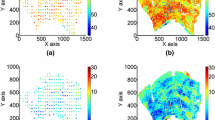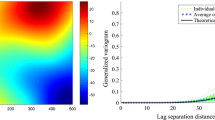Abstract
In this study, developments in the theory of stochastic simulation are discussed. The unifying element is the notion of Radon projection in Euclidean spaces. This notion provides a natural way of reconstructing the real process from a corresponding process observable on a reduced dimensionality space, where analysis is theoretically easier and computationally tractable. Within this framework, the concept of space transformation is defined and several of its properties, which are of significant importance within the context of spatially correlated processes, are explored. The turning bands operator is shown to follow from this. This strengthens considerably the theoretical background of the geostatistical method of simulation, and some new results are obtained in both the space and frequency domains. The inverse problem is solved generally and the applicability of the method is extended to anisotropic as well as integrated processes. Some ill-posed problems of the inverse operator are discussed. Effects of the measurement error and impulses at origin are examined. Important features of the simulated process as described by geomechanical laws, the morphology of the deposit, etc., may be incorporated in the analysis. The simulation may become a model-dependent procedure and this, in turn, may provide numerical solutions to spatial-temporal geologic models. Because the spatial simūlation may be technically reduced to unidimensional simulations, various techniques of generating one-dimensional realizations are reviewed. To link theory and practice, an example is computed in detail.
Similar content being viewed by others
References
Brooker, Peter I., 1985, Two-dimensional simulation by turning bands: Math. Geol., v. 17, n. 1, p. 81–90.
Christakos, George, 1984, The space transformations and their applications in systems modelling and simulation:in Proceedings of the International Conference, AMSE, Modelling and simulation: Athens, Greece, v. 1.3, p. 49–68.
Christakos, George, 1986, Space transformations in the study of multidimensional functions in the hydrologic sciences: Adv. Water Res., v. 9, p. 42–48.
Christakos, George, 1987, The space transformation in the simulation of multidimensional random fields: Mathematics and Computers in Simulation, special issue, Stochastic systems modelling, v. 29, in press.
Cramér, Harald and Wold, Herman, 1936, Some theorems on distribution functions: J. Lond. Math. Soc., v. 18, p. 290–294.
Erdélyi, Arthur; Magnus, Wilhelm; Oberhettinger, Fritz; and Tricouni, Francisco G., 1953, Higher transcendental functions, v. II: McGraw-Hill, New York, 451 p.
Gel'fand, Izrail M.; Graev, Michayl I.; and Vilenkin, Naum Ya., 1966, Generalized functions, v. 5: Academic Press, New York, 449 p.
Harbaugh, John W., 1967, Computer simulation as an experimental tool in geology and paleontology, Essays in paleontology and stratigraphy: University of Kansas, Department of Geology, p. 368–389.
Helgason, Sigurdur, 1980, The Radon transform: Birkhauser, Boston, Basel, Stuttgart, 192 p.
Journel, Andre G., 1974, Geostatistics for conditional simulation of ore bodies: Econ. Geol., v. 69, p. 673–687.
Mantoglou, Aristotelis and Wilson, John L., 1982, The turning bands method for simulation of random fields using line generation by a spectral method: Water Resour. Res., v. 18, n. 5, p. 1379–1394.
Matérn, Bertil, 1960, Spatial variation: Medd. Statens Skogsforsknighinst. Swed., v. 49, n. 5, 144 p.
Matheron, George, 1973, The intrinsic random functions and their applications: Advan. Appl. Prob., v. 5, p. 439–468.
Mizell, Steve A.; Gutjahr, Allan L.; and Gelhar, Lynn W., 1982, Stochastic analysis of spatial variability in two-dimensional steady groundwater flow assuming stationary and nonstationary heads: Water Resour. Res., v. 18, n. 4, p. 1053–1067.
Radon, Johann, 1917, Uber die bestimmung von funktionen durch ihre integradwerte langs gewisser mannigfaltigkeiten, Berichte Sachsische Academic der Wissenschaften, Leipzig: Math. Phys. Kl., v. 69, p. 262–267.
Renyi, Alfréd, 1952, On projections of probability distributions: Acta. Math. Acad. Sci. Budapest, v. 3, p. 131–141.
Rice, Stephen O., 1954, Mathematical analysis of random noise: Selected papers on noise and stochastic processes: Dover Publ., p. 180–181.
Shinozuka, Masanobu and Jan, Chun -M., 1972, Digital simulation of random processes and its applications: J. Sound Vib., v. 25, no. 1, p. 111–128.
Sneddon, Ian N., 1972, The use of integral transforms: McGraw-Hill, New York, 542 p.
Soong, Tsu T., 1973, Random differential equations in science and engineering: Academic Press, New York, 327 p.
Tikhonov, Andrey V. and Arsenin, Vasiliy Y., 1977, Solution of ill-posed problems: Winston & Sons, 258 p.
Vansteenkiste, Ghislain. C., 1975, Computer simulation of water resources systems: Proceedings of IFIP Working Conference on Computer Simulation of Water Resource Systems, Ghent, Belgium, 686 p.
Veneziano, Daniel A., 1980, Random processes for engineering applications: Course notes: Civil Engineering Department, MIT, Cambridge, Massachusetts, 537 p.
Author information
Authors and Affiliations
Rights and permissions
About this article
Cite this article
Christakos, G. Stochastic simulation of spatially correlated geo-processes. Math Geol 19, 807–831 (1987). https://doi.org/10.1007/BF00893018
Received:
Accepted:
Issue Date:
DOI: https://doi.org/10.1007/BF00893018




